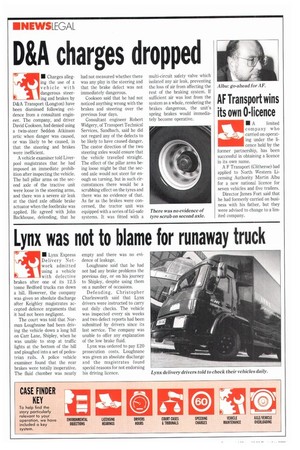D&A charges dropped
Page 16

If you've noticed an error in this article please click here to report it so we can fix it.
'IF
• Charges alleging the use of a vehicle with dangerous steering and brakes by D&A Transport (Longton) have been dismissed following evidence from a consultant engineer. The company, and driver David Cookson, had denied using a twin-steer Seddon Atkinson artic when danger was caused, or was likely to be caused, in that the steering and brakes were inefficient.
A vehicle examiner told Liverpool magistrates that he had imposed an immediate prohibition after inspecting the vehicle. The ball pillar arms on the second axle of the tractive unit were loose in the steering arms, and there was a severe air leak at the third axle offside brake actuator when the footbrake was applied. He agreed with John Backhouse, defending, that he had not measured whether there was any play in the steering and that the brake defect was not immediately dangerous.
Cookson said that he had not noticed anything wrong with the brakes and steering over the previous four days.
Consultant engineer Robert Widgery, of Transport Technical Services, Sandbach, said he did not regard any of the defects to be likely to have caused danger. The castor direction of the two steering axles would ensure that the vehicle travelled straight. The effect of the pillar arms being loose might be that the second axle would not steer far enough on turning, but in such circumstances there would be a scrubbing effect on the tyres and there was no evidence of that. As far as the brakes were concerned, the tractor unit was equipped with a series of fail-safe systems. It was fitted with a multi-circuit safety valve which isolated any air leak, preventing the loss of air from affecting the rest of the braking system. If sufficient air was lost from the system as a whole, rendering the brakes dangerous, the unit's spring brakes would immediately become operative.
















































































